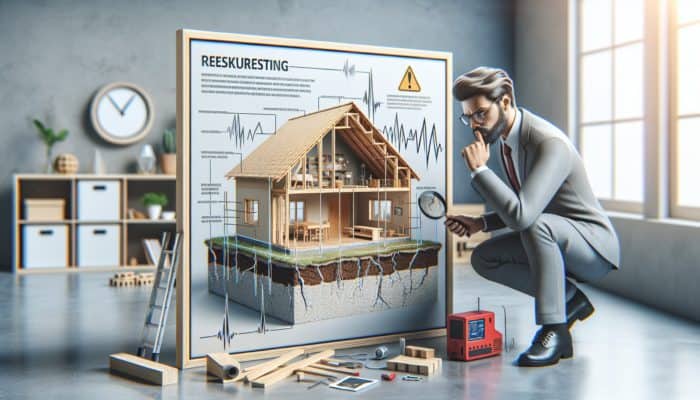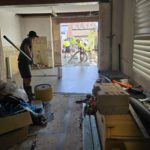Enhance Your Earthquake Preparedness by Understanding Associated Risks
What Are the Primary Factors Behind Earthquake Events?

Earthquakes are predominantly instigated by the dynamic activity of tectonic plates, which are enormous segments of the Earth's crust drifting on the semi-fluid mantle below. These plates may collide, separate, or slide past one another, generating friction that accumulates vast amounts of energy over time. When this energy is finally released, it produces seismic waves that cause ground shaking. Gaining insight into these geological dynamics is essential for accurately anticipating and preparing for seismic occurrences. The primary catalysts for earthquakes are:
- Movements of tectonic plates
- Volcanic activity
- Human-induced actions such as mining operations and the effects of water reservoirs
- Shifts along fault lines
- Land subsidence or sinking issues
- Accumulation of stress in the Earth’s crust
- Aftershocks that take place following initial seismic events
Recognizing these earthquake triggers is crucial for improving community readiness and ensuring personal safety during seismic events.
How to Assess Your Home’s Vulnerability to Earthquake Damage
Evaluating your living environment for possible weaknesses is a vital step in earthquake preparedness. Neglecting to address these risks can lead to severe injuries or extensive property damage during an earthquake. Begin by pinpointing heavy furniture and unsecured items that could turn into dangerous projectiles when shaken. Pay close attention to critical areas, such as:
- Bookcases and shelving units
- Heavy appliances like refrigerators and washing machines
- Mirrors and wall-mounted picture frames
- Hanging plants and light fixtures
- Windows and sliding glass doors
- Garage tools and equipment
- Outdoor structures such as balconies and patios
By properly securing these items, you can significantly lessen the risk of injury and property destruction. Start by anchoring tall furniture to the wall and utilizing safety straps for heavier appliances. This proactive evaluation not only safeguards your home but also fosters a safer living environment for all family members.
Why Are Early Warning Systems Essential for Earthquake Preparedness?
Early warning systems serve a critical function in earthquake readiness by providing vital seconds or even minutes of advance notice before seismic activity begins. These pivotal moments can be life-saving, allowing individuals to take protective measures such as seeking cover, shutting off gas lines, or evacuating if required. Many areas around the globe are investing in sophisticated seismic networks designed to monitor tectonic movements and send alerts to mobile devices or emergency systems. The efficiency of these technologies significantly enhances community preparedness and individual responsiveness during seismic events. Furthermore, public awareness regarding these alerts is crucial; understanding how to react when an alert is issued can further alleviate risks during an earthquake.
How to Assemble a Comprehensive Earthquake Emergency Kit

Creating a well-stocked emergency kit is a fundamental aspect of earthquake preparedness. A thoughtfully curated kit ensures that you can meet immediate needs following a seismic event. Essential items to incorporate are:
- At least one gallon of water per person per day for a minimum of three days
- Non-perishable food items sufficient for three days
- A flashlight with extra batteries
- A thorough first aid kit
- A whistle for signaling assistance
- A dust mask to filter contaminated air
- Moist towelettes, garbage bags, and plastic ties for sanitation purposes
- A versatile Multi-tool for various needs
Regularly check and replenish your emergency kit to ensure that all items are functional and not expired. Tailor your kit to the specific number of individuals in your household and their unique needs, including essential medications or baby supplies. This preparedness effort not only provides peace of mind but also enhances your overall safety in the event of a disaster.
Why Is Participation in Community and Government Preparedness Programs Crucial?
Engaging in local earthquake drills and understanding government initiatives is essential for strengthening community resilience. Numerous regions offer programs specifically designed to educate citizens about earthquake risks and response strategies. Local authorities frequently provide valuable resources such as workshops and educational materials. Participation in these initiatives equips you with crucial knowledge about local geological conditions, emergency services, and evacuation routes. Additionally, communities can benefit from establishing preparedness networks that promote communication and resource sharing. Through collaboration, residents can foster a culture of safety and resilience, empowering everyone to respond effectively to earthquakes.
Expert Insights on Earthquake Preparedness Strategies
How Can Professionals Support Earthquake Preparedness Initiatives?

Consulting with earthquake preparedness specialists can provide tailored guidance based on the latest research and technological advancements. These professionals typically conduct comprehensive assessments of homes and communities, pinpointing specific vulnerabilities and recommending effective mitigation strategies. For instance, they may propose enhancements to structural integrity or advise on the installation of early warning systems. Real-world success stories illustrate the advantages of expert involvement; regions cooperating with seismic safety consultants frequently report improved safety ratings and decreased damage incidences following earthquakes. By leveraging expert knowledge, individuals and communities can enhance their preparedness measures and fortify their resilience against seismic threats.
What Are the Most Recent Technological Innovations in Earthquake Preparedness?
Recent technological advancements are rapidly transforming earthquake detection and response capabilities. Innovations such as smartphone applications provide real-time information, allowing users to receive alerts and safety guidance directly on their devices. Additionally, breakthroughs in sensors and data analytics improve the accuracy and speed of earthquake detection. Communities can integrate these technologies into their preparedness strategies by:
- Downloading reputable earthquake alert applications
- Joining community-based alert networks
- Utilizing building management systems that monitor structural stability
- Investing in smart home technologies that automate safety measures
These actionable steps empower individuals to stay informed and prepared, making technology a vital ally in effectively addressing earthquake risks.
What Role Do Simulations Play in Enhancing Earthquake Preparedness?
Simulations are critical for earthquake preparedness, enabling communities to practice their emergency response strategies. These drills help identify weaknesses in existing plans and improve coordination among various stakeholders, including local authorities and emergency services. Research indicates that communities participating in regular earthquake simulation exercises tend to exhibit quicker response times and lower casualty rates during actual incidents. Expert evaluations reveal that these drills enhance not only physical readiness but also mental preparedness among participants. By creating simulated real-world scenarios, individuals can gain confidence and familiarity with emergency procedures, making decisive action more likely in the event of an earthquake.
Crafting a Tailored Earthquake Preparedness Plan
What Essential Components Should Be Included in Your Earthquake Preparedness Plan?
A comprehensive personal earthquake preparedness plan is vital for ensuring safety during seismic events. It should encompass various essential elements designed to equip individuals and families for emergencies. Key components of an effective earthquake preparedness plan include:
- Clearly defined and rehearsed evacuation routes
- Emergency contact lists, detailing family members, friends, and local authorities
- Designated meeting points outside of the home
- Information regarding the locations of emergency kits
- Communication protocols, especially for family members in different locations
- Plans for the care of pets or livestock during emergencies
- Specific roles assigned to family members during an emergency
Regularly updating this plan is essential as circumstances evolve, ensuring that all household members are aware of procedures and responsibilities. By establishing a comprehensive earthquake preparedness plan, families can navigate the chaos of an earthquake with greater confidence and clarity.
How to Conduct Effective Drills for Your Earthquake Preparedness Plan
Regularly practicing your earthquake preparedness plan is crucial for ensuring that everyone knows how to respond during a real emergency. Drills should not only be scheduled but also designed to mirror various scenarios, such as different times of day or specific hazards. This practice can dramatically improve response times and overall effectiveness during an actual earthquake. Involving family members of all ages in these drills fosters engagement and reinforces the importance of preparedness. Consider the following strategies for effective practice:
- Conduct drills at different times of the day to test readiness
- Evaluate the plan after each drill, identifying areas for improvement
- Include neighbors to promote community preparedness
- Facilitate open discussions about fears and safety concerns
Practicing your earthquake preparedness plan turns theoretical knowledge into practical skills, enabling your family to respond effectively when it counts the most.
Why Is Effective Communication Vital in Your Earthquake Preparedness Plan?
Strong communication is integral to any earthquake preparedness plan. Establishing clear communication protocols among family members can greatly enhance safety and coordination during and after an earthquake. This includes designating a primary point of contact outside the household for updates and information regarding each member’s safety. Utilizing various communication methods, such as text messaging, social media, and designated family applications, ensures multiple channels of contact. Families should prepare for scenarios where phone lines may become congested, emphasizing alternative communication options. Keeping family members informed not only aids in the immediate aftermath but also fosters a sense of support and unity in the chaos following an earthquake.
Proven Strategies for Securing Homes and Workplaces Against Earthquakes
What Essential Items Should Be Secured to Mitigate Earthquake Damage?
Securing items in both your home and workplace is paramount for minimizing injuries and property damage during an earthquake. Heavy furniture, appliances, and shelves are particularly susceptible to toppling, making proper anchoring essential. To create a safer environment, evaluate the following items:
- Bookcases and cabinets
- Televisions and other electronic devices
- Heavy appliances like stoves and refrigerators
- Artwork and mirrors
- Outdoor furniture and fixtures
- Floor lamps and hanging decorations
- Office equipment such as printers and monitors
To secure these items effectively, consider using brackets, straps, and adhesive putty to ensure everything is anchored securely. This preventative approach can significantly decrease the likelihood of injury and property loss, providing peace of mind during seismic events.
How to Reinforce Building Structures for Enhanced Earthquake Safety?
Strengthening building structures represents a proactive strategy for earthquake preparedness that can substantially reduce damage and save lives. Techniques such as bracing walls, retrofitting foundations, and installing flexible utility connections can greatly enhance structural integrity. These upgrades are especially critical in regions prone to seismic activity. Communities should encourage property owners to adopt such measures, which may include:
- Reinforcing load-bearing walls
- Utilizing shear walls to absorb seismic forces
- Incorporating base isolators that allow buildings to move independently from ground motion
- Ensuring roofs are securely anchored
- Conducting regular inspections to identify vulnerabilities
By investing in structural improvements, property owners not only protect their investments but also contribute to the overall safety and resilience of their communities.
What Essential Items Should Be Included in Your Emergency Kits?
An effective emergency kit is an essential component of earthquake preparedness. It should contain critical items that ensure survival in the immediate aftermath of a seismic event. Key contents of an emergency kit include:
- A minimum of three days’ worth of non-perishable food
- A water supply of at least one gallon per person per day
- A battery-operated or hand-crank radio
- Flashlight along with extra batteries
- First aid supplies and any necessary prescriptions
- Multi-tool for various needs
- Comfort items such as blankets or sleeping bags
- Cash in small denominations
Regular evaluations and replenishments of the emergency kit are crucial to ensure that all items remain functional and up-to-date. Customize the kit to address the specific needs of each family member, including pets. By maintaining this preparedness measure, individuals can navigate the uncertainty following an earthquake with greater confidence and capability.
Research-Based Advantages of Earthquake Preparedness
How Does Preparedness Contribute to Damage Mitigation?
Being well-prepared can significantly reduce both structural damage and personal injuries during an earthquake. Homes and workplaces that have undergone vulnerability assessments and retrofitting typically experience less damage during seismic events. Real-world case studies validate this: communities that have enforced strict building codes and conducted public education initiatives often report lower casualty rates and diminished property loss. Implementing safety measures, such as securing heavy furniture and practicing evacuation protocols, considerably lowers the risk of injuries. Ultimately, fostering a culture of preparedness cultivates resilience, turning potential disasters into manageable situations.
What Psychological Benefits Are Linked to Earthquake Preparedness?
Being prepared for an earthquake can provide several psychological advantages, primarily by reducing anxiety and stress associated with potential disasters. Knowing that a comprehensive plan is in place fosters a sense of control and security among individuals. Practical steps to maintain mental well-being during preparation include creating checklists, engaging in family discussions about safety, and participating in community drills. These activities boost confidence and promote a proactive mindset. Furthermore, the act of preparing itself serves as a coping strategy, shifting focus from fear to empowerment. By nurturing a sense of community through shared experiences, individuals can further alleviate anxiety and enhance psychological resilience.
What Economic Benefits Are Associated with Earthquake Preparedness?
Communities that actively prepare for earthquakes reap substantial economic benefits. Effective preparedness not only mitigates property damage but also accelerates recovery efforts. When businesses and homes are better equipped to withstand seismic events, the costs associated with repairs and subsequent economic disruptions are considerably reduced. Research indicates that regions with comprehensive preparedness strategies can recover more quickly, minimizing long-term economic impacts. Communities investing in earthquake readiness often see reduced insurance premiums and increased property values. Ultimately, the economic rationale for preparedness is compelling: robust planning leads to resilient communities capable of thriving amidst adversity.
The Role of Community and Government in Earthquake Preparedness
What Initiatives Can Communities Undertake to Enhance Preparedness?
Communities can implement various strategies to bolster earthquake preparedness, fostering a culture of safety and resilience. Organizing regular drills helps familiarize residents with emergency protocols and nurtures teamwork within the community. Education is vital; providing workshops and informational sessions empowers individuals with essential knowledge about earthquakes. Additionally, local organizations can create emergency response plans tailored to the specific needs of their communities. Forming partnerships with schools, businesses, and non-profit organizations improves resource allocation and coordination during preparedness efforts. By collaborating, communities can establish strong support networks that will effectively respond during an earthquake.
How Do Governments Facilitate Earthquake Preparedness Initiatives?
Governments play a pivotal role in promoting earthquake preparedness through policy implementation, funding research, and providing resources to citizens. By instituting stringent building codes and regulations, governments can ensure that new constructions are designed to withstand seismic forces. Investing in public awareness campaigns educates citizens about earthquake risks and preparedness strategies, fostering a culture of safety. Furthermore, government funding for research on seismic activity and infrastructure enhancements is essential for effective contingency planning. In numerous regions, dedicated emergency management agencies coordinate disaster response initiatives and community engagement, creating a comprehensive preparedness framework.
Why Are Public Awareness Campaigns Critical for Earthquake Preparedness?
Public awareness campaigns are vital for informing individuals about the significance of earthquake preparedness. Effectively communicating risks and strategies encourages proactive measures within communities. These campaigns can utilize social media, public service announcements, and community events to reach a diverse audience. By actively engaging the public, these initiatives emphasize the importance of preparedness and motivate individuals to take necessary actions. Moreover, incorporating testimonials from survivors can provide real-life insights into the critical nature of readiness. Ultimately, successful public campaigns cultivate a knowledgeable community that is better equipped to respond to earthquakes.
Recovery and Resilience After an Earthquake
What Immediate Steps Should Be Taken After Experiencing an Earthquake?
Immediately following an earthquake, it is crucial to take specific actions to ensure safety and facilitate recovery efforts. First, check yourself and others for injuries, providing first aid as necessary. Next, assess your surroundings for hazards, including checking for gas leaks or damaged electrical lines, as these can pose significant risks. Contacting emergency services is essential, especially if there are life-threatening situations or fires. Remaining calm and assisting others, particularly children and the elderly, is vital in navigating the aftermath. Establish communication with family members to confirm everyone's safety and relay information regarding evacuation if needed. By following these steps, individuals can lay a solid foundation for recovery.
How to Build Long-Term Resilience After an Earthquake?
Fostering long-term resilience post-earthquake requires learning from previous events and enhancing infrastructure and preparedness strategies. Communities can conduct thorough evaluations of their responses to identify successes and areas needing improvement. Investing in infrastructure upgrades that incorporate seismic-resistant designs is crucial for ensuring future safety. Ongoing educational programs about earthquake preparedness and community drills keep residents informed and engaged in resilience initiatives. Additionally, nurturing a culture of support and resource sharing strengthens overall community resilience. By prioritizing initiatives aimed at building resilience, communities can better equip themselves for future challenges and lessen the impacts of seismic events.
How to Support Communities Impacted by an Earthquake?
In the aftermath of an earthquake, aiding affected communities is essential for their recovery and future preparedness. Support can take various forms, including providing financial assistance, essential resources, and emotional backing. Participating in volunteer efforts to assist with cleanup and rebuilding is vital for fostering community solidarity. Organizing donation drives for critical supplies, housing support, and mental health resources can also be immensely beneficial. Furthermore, facilitating communication between impacted individuals and local agencies ensures that their needs are effectively addressed. Supporting one another cultivates a resilient environment where communities can recover and enhance their preparedness for future earthquakes.
What Are the Benefits of Strengthening Building Codes and Regulations?
Improving building codes and enforcing regulations are fundamental strategies for preventing future damage in earthquake-prone areas. Governments and local authorities must prioritize implementing rigorous codes that require new constructions to comply with seismic safety standards. Regular inspections and enforcement ensure adherence, mitigating risks associated with substandard buildings. Communities should advocate for retrofitting older structures to meet current safety standards, thereby enhancing overall resilience. By investing in sound building practices, communities can significantly reduce the likelihood of catastrophic damage during seismic events, promoting safety and security in challenging circumstances.
Frequently Asked Questions (FAQs)
What steps should I take to prepare for an earthquake?
Prepare by developing a comprehensive emergency plan, securing heavy furniture, assembling an emergency kit, and engaging in community preparedness programs.
How can I effectively secure my home against earthquakes?
Secure your home by anchoring heavy furniture, reinforcing structures, and ensuring that all items that could potentially fall are properly secured.
Why is having an emergency kit essential?
An emergency kit ensures you have essential supplies like food, water, and first aid during the immediate aftermath of an earthquake.
How can technology enhance earthquake preparedness?
Technology offers real-time alerts through applications, improves monitoring systems, and facilitates communication, significantly boosting preparedness and response.
What is the significance of community drills?
Community drills enhance collective readiness and help identify areas for improvement in emergency plans through practical scenarios.
What should I incorporate into my earthquake plan?
Your earthquake plan should include evacuation routes, emergency contacts, meeting points, and communication protocols tailored to your family’s needs.
How can I alleviate anxiety about earthquakes?
Reduce anxiety by staying informed, preparing thoroughly, and practicing your emergency plan, which cultivates confidence in your ability to respond.
What role do governments play in earthquake preparedness?
Governments facilitate preparedness through policy implementation, funding research, providing resources, and organizing public education initiatives.
How can I assist my community after an earthquake?
Support your community by volunteering for recovery efforts, donating essential supplies, and helping to facilitate communication and resources for those affected.
What are the economic advantages of earthquake preparedness?
Economic advantages include reduced property damage, quicker recovery times, lower insurance premiums, and enhanced community resilience, minimizing long-term disruptions.
Explore more with us on X!
The post Preparing for Earthquakes: Essential Tips and Strategies appeared first on Survival Bite.
The Article Earthquake Preparedness: Key Tips and Strategies Was Found On https://limitsofstrategy.com

